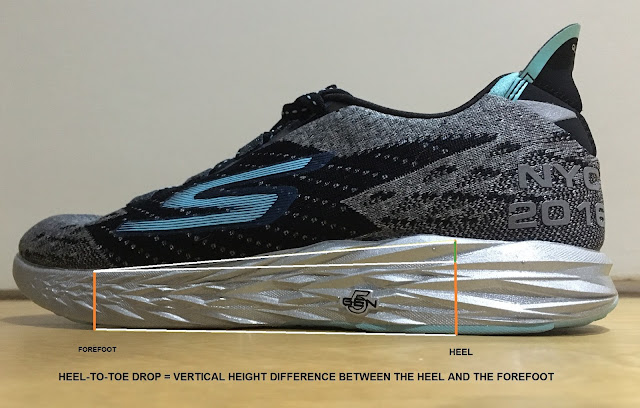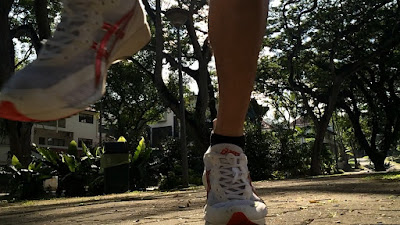Shoe Heel-to-Toe Drop: What it means for you
I’ve received some feedback about confusion regarding the
definition of shoe heel-to-toe drop, and its implications for running style.
Therefore, I am writing this brief article to try and explain what it all means
for the average runner looking to buy a new pair of running shoes.
You may sometimes come across terms like heel-to-toe offset,
or heel-to-toe drop when you look at the technical information about a
particular running shoe model. They pretty much all mean the same thing: the
difference in height between the rear part of a shoe and the front. Bear in
mind that all technical data are generally given for a size US9.0 shoe. It goes
without saying that a smaller sized shoe with the same heel-to-toe drop would have a steeper ramp angle (that's the slope from the heel to the forefoot). [This section was edited on 27 Nov 16 2348Hrs. Thanks to Andy Neo for the correction] It is for this reason that brands like ASICS do
not advertise the heel-to-toe drops for their shoes on their media platforms but prefer to focus on ramp
angle, or the steepness of the slope between the heel and the front of the
shoe.
Another important caveat to interpreting the heel-to-toe
drop of a shoe is that these numbers are measured in an unweighted environment.
What does this mean? It means that if the midsole of the shoe you use is soft,
and your foot sinks down when you run in the shoe, then the heel-to-toe drop when you are running will be smaller than advertised, as your foot
generally sinks more in the heel than the forefoot since there is more material
to compress in the heel.
In the current retail market, there is a very wide range of
shoes with different heel to toe drops.
At the high end of the spectrum, you are looking at 10-12mm
of drop, and these are what one would call a tradition shoe. Most traditional
drop shoes tend to have a 10mm drop these days, and there are far too many to
name here, but typical examples are the Brooks Launch, or the Adidas
Adios/Boston/Energy Boost. There are still some 12mm drop shoes on the market
but they are harder to find these days. Examples are the Mizuno Wave Rider 19,
Brooks Adrenaline GTS, and Brooks Ghost 9. By and large, you will find that the
heavier trainers from all the major brands will skew towards a 10-12mm
heel-to-toe drop. It is generally thought that a higher heel-to-toe drop is
more suited for heel strikers, as the added shoe thickness in the heel will
help to provide more impact protection for the runner. In practical terms
though, there are lots of forefoot and midfoot strikers who frequently use
traditional drop shoes without any problems.
In recent years, a more moderate drop category has become
more popular and this category covers anywhere from 4mm-8mm drop. The idea
behind the lower drop shoes is that for runners who do not heel-strike, a thicker heel will “catch” the ground prematurely
during the stride cycle even if the runner is not a heel-striker. That may
hamper the runner’s natural stride, or force him/her to point their toes down
more than necessary to achieve a mid-forefoot strike and that can lead to other
mechanical problems or injuries. Again, in practical terms, there are lots of
heel-strikers who can get away with moderate drop shoes, with the right amount
of cushioning in the shoe. Examples of moderate drop shoes are as follows:
4mm – Saucony Kinvara, Skechers GoRun 4 / 5, Brooks Pure
Series, Nike Free RN Distance, Hoka Tracer, Hoka Clayton, Hoka Bondi
5mm – Hoka Clifton, Hoka Vanquish 2, Topo Magnifly, Topo
Ultrafly, Salming Distance, Newton Distance Elite
6mm – New Balance Vazee Pace / Zante, Hoka Stinson 3, ASICS
Hyperspeed 7, Adidas Takumi Sen 3
7mm – Nike Lunaracer, ASICS Tartherzeal
8mm – Saucony Ride 9, New Balance 1080v6, Brooks Transcend,
Nike Zoom Streak 6, Nike Lunartempo, ASICS Dynaflyte, ASICS DS Racer
Finally, there is the low drop range. Low drop shoes are the
newest category on the market, and include brands like Newton, Vibrams, Altra
and Carson. I put 0-3mm drop as a low drop category as for practical purposes,
you won’t feel any heel when you run in these types of shoes. These shoes are
targeted at the forefoot striking runners who do not like any heel in their
shoes to affect their stride. Most of the Newton shoes are low drop, and you
can see the drop designation on the side of the shoes. All the Altra models are
zero drop. Altra is an interesting brand because I believe they were the first
to admit that zero drop did not have to mean zero cushioning, and it was
possible, indeed favourable, to have a highly cushioned shoe to cater to
forefoot runners, and some of their models like the Torin 2.5 and Paradigm do
provide excellent cushioning in a zero drop package.
The lists are by no means exhaustive but you can see that a
lot of brands have shoes with different drops and there is no clear trend on
what type of shoe has a tendency to what type of drop. The reason for this is
simple. There is no clear evidence that says any particular drop works best for
any particular type of training/racing. You will find racing shoes with relatively
low drops like the Hoka Tracer at 4mm, and racers with very high drops like the
(discontinued) Brooks T7 with its 12mm drop, or traditional drop racers at 10mm
like the New Balance 1400 series, or Adidas Adios. Similarly, there are heavy
duty trainers on the market like the Hoka Bondi at 4mm, and the Brooks Ghost at
12mm.
This article is not
meant to tell you what type of drop is best for you. Choosing a shoe that
works well is so much more than heel to toe drop, and I for one almost never
take shoe drop into consideration when choosing a shoe. However, generally,
traditional drop shoes can work for the widest audience, while zero drop shoes
have the smallest margin for error as a heel-striker will notice the lack of
cushioning with a zero drop shoe much more than a forefoot striker with a
traditional drop shoe. It is best to test
out different types of shoes to see what works best for you, and to always
transition into a new shoe slowly to let your body adapt to the shoe over the course
of 1-2 weeks.




This comment has been removed by the author.
ReplyDeleteThanks for compiling this amazing post. I was wondering what designs are in and out to pick up shoes. This has given me a clear idea. We have also more option for shoes: Shoes Manufacturer In Agra
ReplyDeleteYour post really a great post. I inspired from your this post. I want to do something awesome for me. Please write more like this for us.
ReplyDeleteIt was really insightful.
ReplyDeleteThanks for the info.
Wanna have more contents from you.
Cheers
BTW if anyone interested more have a look Click Here For Visit My Site thanks
This comment has been removed by the author.
ReplyDeleteThis is also good and use as comfortable shoes
ReplyDeleteThank you so much for sharing all this wonderful info with the how-to's!!!! It is so appreciated!!! You always have good humor in your posts/blogs. So much fun and easy to read!
ReplyDeleteDrop Compress Crack
Sweet Home 3D Crack